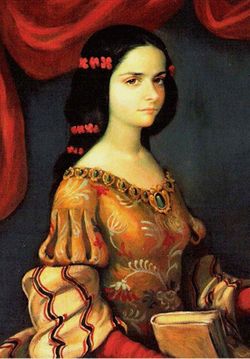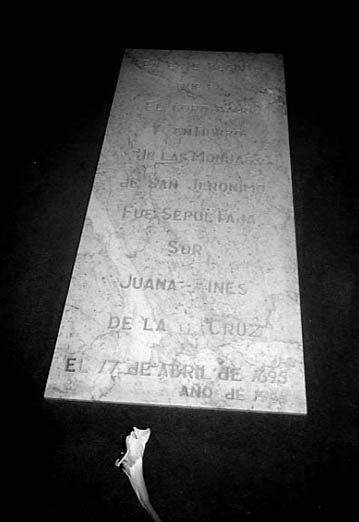Writer, poet, philosopher, astronomer, painter, musician, nun, feminist. Juana Inés Ramírez de Asbaje was born in San Miguel de Nepantla, Nueva España (now Mexico), on December 2, 1648. She was the daughter of Pedro Manuel Asbaje y Vargas Machuca and Isabel Ramírez de Santillana. At a time when few men could read and write, she secretly learned to read at age three. Years later, she went to Mexico City where after disguising herself as a man, she devoted herself to the study of Latin, a language that she mastered in only twenty lessons. At the age of seventeen, Juana brilliantly proved her intellectual genius in successfully passing a public oral examination by several Mexican scholars of her time. On February 21, 1669, Juana entered the Convent of the Order of St. Jerome where she adopted the name of Sor Juana Inés de la Cruz. Her intellectual and scientific curiosity gained her the admiration of the most outstanding scholars and writers of the New World. In 1689 the Countess of Paredes sponsored the first edition of Sor Juana's Inundación Castálida. In spite of her fame as a poet and playwright, Sor Juana had to constantly defend her intellectual vocation within a society where the realm of academia was strictly reserved for men, its writers were men and its readers were men. This is why it is so extraordinary that the greatest writer to emerge from Nueva España, the first great poet of Spanish America, was Sor Juana Inés de la Cruz, a woman. In Sor Juana's famous autobiographical essay, "Respuesta a Sor Filotea de la Cruz" (1691) the Mexican nun justifies her scholarly vocation and admits that convent life was the most decent path she could follow since she felt total abhorrence towards marriage. In 1692, the first edition of the second volume of her works was successfully published in Seville, however, the Mexican nun had already decided to give up her studies and writing to devote herself completely to religious life. She sold all her books, a vast personal library which exceeded 4,000 volumes, her musical and scientific instruments, donating all the proceeds to charity. A year later, she contracted cholera during an epidemic and died on April 17, 1695 in Distrito Federal, México. As was the custom of the day, she was interred in the Monasterio del Señor San Jerónimo de la Ciudad de México.
Writer, poet, philosopher, astronomer, painter, musician, nun, feminist. Juana Inés Ramírez de Asbaje was born in San Miguel de Nepantla, Nueva España (now Mexico), on December 2, 1648. She was the daughter of Pedro Manuel Asbaje y Vargas Machuca and Isabel Ramírez de Santillana. At a time when few men could read and write, she secretly learned to read at age three. Years later, she went to Mexico City where after disguising herself as a man, she devoted herself to the study of Latin, a language that she mastered in only twenty lessons. At the age of seventeen, Juana brilliantly proved her intellectual genius in successfully passing a public oral examination by several Mexican scholars of her time. On February 21, 1669, Juana entered the Convent of the Order of St. Jerome where she adopted the name of Sor Juana Inés de la Cruz. Her intellectual and scientific curiosity gained her the admiration of the most outstanding scholars and writers of the New World. In 1689 the Countess of Paredes sponsored the first edition of Sor Juana's Inundación Castálida. In spite of her fame as a poet and playwright, Sor Juana had to constantly defend her intellectual vocation within a society where the realm of academia was strictly reserved for men, its writers were men and its readers were men. This is why it is so extraordinary that the greatest writer to emerge from Nueva España, the first great poet of Spanish America, was Sor Juana Inés de la Cruz, a woman. In Sor Juana's famous autobiographical essay, "Respuesta a Sor Filotea de la Cruz" (1691) the Mexican nun justifies her scholarly vocation and admits that convent life was the most decent path she could follow since she felt total abhorrence towards marriage. In 1692, the first edition of the second volume of her works was successfully published in Seville, however, the Mexican nun had already decided to give up her studies and writing to devote herself completely to religious life. She sold all her books, a vast personal library which exceeded 4,000 volumes, her musical and scientific instruments, donating all the proceeds to charity. A year later, she contracted cholera during an epidemic and died on April 17, 1695 in Distrito Federal, México. As was the custom of the day, she was interred in the Monasterio del Señor San Jerónimo de la Ciudad de México.
Bio by: Debbie
Advertisement
See more de la Cruz memorials in:
Explore more
Sponsored by Ancestry
Advertisement




